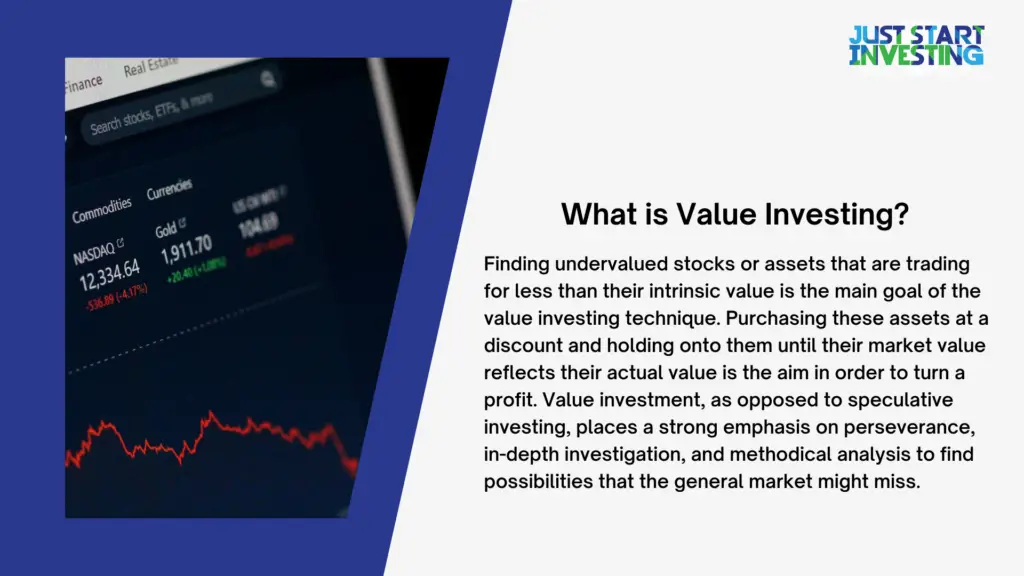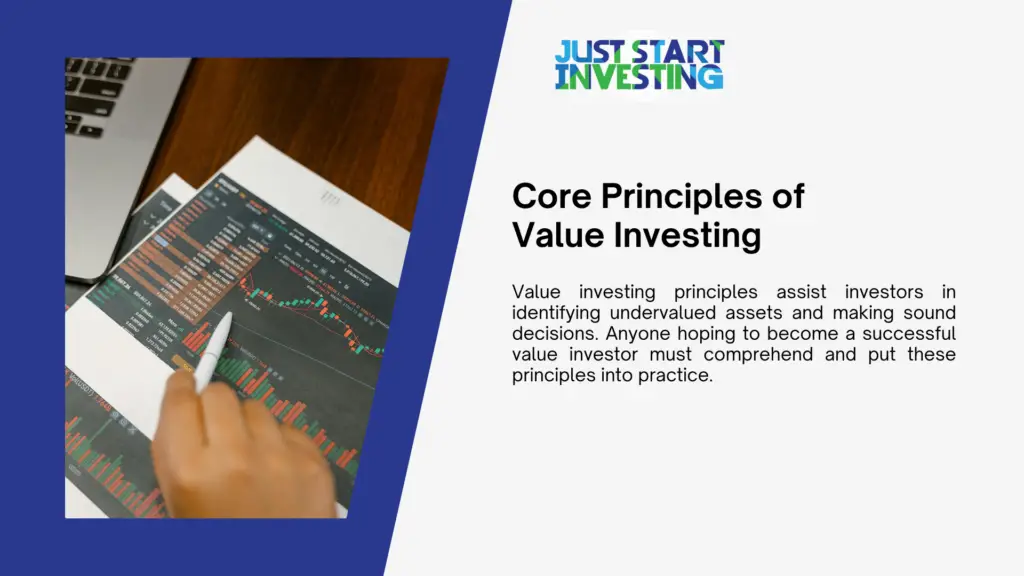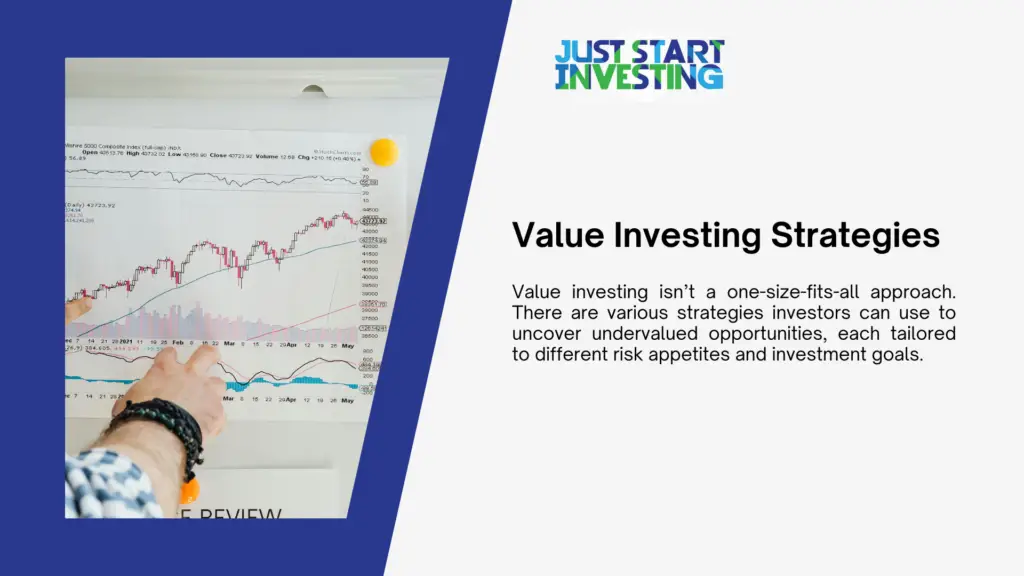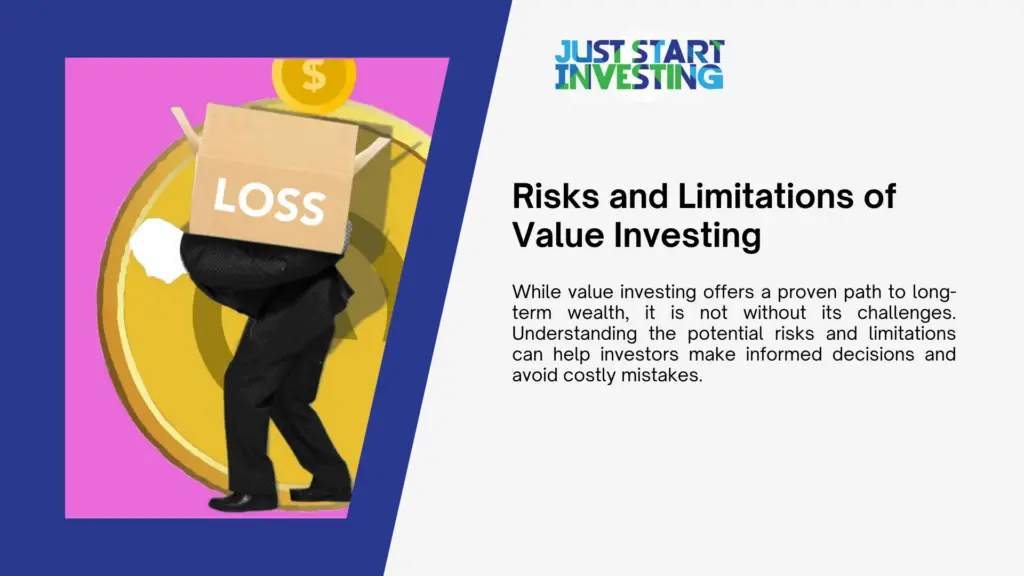Value investing is an effective and disciplined investment strategy that has stood the test of time. This method, which focuses on discovering inexpensive stocks with solid fundamentals, provides a means to generate wealth through thorough analysis and patience. In this tutorial, we’ll look at the principles, tactics, and real-world examples of value investing, so you can confidently navigate the market and make informed investment decisions.
What is Value Investing?

Finding undervalued stocks or assets that are trading for less than their intrinsic value is the main goal of the value investing technique. Purchasing these assets at a discount and holding onto them until their market value reflects their actual value is the aim in order to turn a profit. Value investment, as opposed to speculative investing, places a strong emphasis on perseverance, in-depth investigation, and methodical analysis to find possibilities that the general market might miss.
Definition and Concept of Value Investing
Value investing revolves around the principle of finding securities that are undervalued by the market. This approach requires a comprehensive understanding of the company’s fundamentals, including its financial statements, earnings, dividends, and management quality.
Difference Between Value Investing and Growth Investing
While value investing focuses on undervalued stocks, growth investing targets companies expected to grow significantly in revenue and profits. Understanding these differences helps investors choose the strategy that aligns with their goals and risk tolerance.
History and Evolution of Value Investing
The roots of value investing can be traced back to Benjamin Graham and David Dodd, who established the framework for value investing in their book, Security Analysis (1934). This approach has been refined over decades by successful investors like Warren Buffett, who expanded on the principles by incorporating qualitative aspects into the analysis.
Why Value Investing Works
Value investing is a dependable strategy for building wealth over time. The basic idea of purchasing assets below their actual value and waiting for the market to determine their value is what makes it so effective.
Underlying Principles of Value Investing
Value investing is based on the fundamental idea that markets are not always efficient. Mispriced assets are frequently the result of emotions, prejudices, and short-term thinking. By prioritizing intrinsic value over market trends, value investors are able to spot lucrative possibilities that others may have missed.
Why Long-Term Investing Pays Off
Value investing is not about quick wins. It takes time and discipline to allow inexpensive stocks to reach their full potential. Historical evidence shows that long-term investors who apply value investing principles tend to outperform those who chase market trends.
Evidence of Success Through Examples
The success of legendary investors like Warren Buffett and Benjamin Graham provides compelling evidence of the effectiveness of value investing. From purchasing undervalued stocks during market downturns to holding investments for decades, their results demonstrate the power of this approach.
Core Principles of Value Investing

Value investing principles assist investors in identifying undervalued assets and making sound decisions. Anyone hoping to become a successful value investor must comprehend and put these principles into practice.
Understanding Intrinsic Value
Intrinsic value is the true worth of an asset based on its fundamentals, such as earnings, revenue, assets, and growth potential. To identify undervalued prospects, value investors conduct in-depth investigation and compare it to the market price.
Margin of Safety
The margin of safety principle ensures that investors buy stocks at a price significantly lower than their estimated intrinsic value. This cushion minimizes risk, providing protection against errors in calculation or unforeseen market shifts.
Patience and Discipline
Successful value investing requires a long-term perspective, avoiding the temptation to react to short-term market fluctuations. Investors must be disciplined, sticking to their principles even when markets are volatile or trending away from their predictions.
Fundamental Analysis
Evaluating a company’s financial health, including its sales, earnings, assets, liabilities, and overall business strategy, is known as fundamental analysis. To accurately measure intrinsic value, qualitative factors like competitive positioning and managerial caliber are also considered.
How to Measure Value Investing
Measuring value investing involves analyzing a company’s financial health and potential for future growth. By using various metrics, tools, and methodologies, investors can determine whether an asset is undervalued and worth purchasing.
Financial Ratios
Financial ratios are essential tools for value investors. Common ratios include:
- Price-to-Earnings (P/E) Ratio: Measures a company’s current share price relative to its earnings per share.
- Price-to-Book (P/B) Ratio: Compares a company’s market value to its book value, helping identify undervalued assets.
- Debt-to-Equity Ratio: Indicates the financial leverage of a company, which is important for assessing risk.
- Dividend Yield: This shows how much a company pays in dividends relative to its stock price, which can be a sign of financial stability.
Qualitative Analysis
Beyond numbers, value investors consider qualitative factors such as:
- Management Quality: Assessing the track record, leadership style, and decision-making capabilities of executives.
- Competitive Positioning: Understanding a company’s market share, competitive advantage, and growth potential.
- Industry Trends: Evaluating broader market conditions and how they might affect the company’s future performance.
Quantitative Analysis
Quantitative analysis involves diving into financial statements, looking at revenue, profits, expenses, and cash flow. Historical trends are also examined to predict future performance and estimate intrinsic value.
Tools and Resources for Valuation
Investors use various tools to simplify the valuation process, including:
- Discounted Cash Flow (DCF) Analysis: Calculating the present value of future cash flows to determine intrinsic value.
- Stock Screeners: Filtering stocks based on specific metrics like P/E ratios, dividend yields, or debt levels.
- Financial Statements Analysis: Reviewing balance sheets, income statements, and cash flow statements.
Value Investing Strategies

Value investing isn’t a one-size-fits-all approach. There are various strategies investors can use to uncover undervalued opportunities, each tailored to different risk appetites and investment goals.
Contrarian Investing
Contrarian investing focuses on going against the prevailing market sentiment. When a stock is unfairly punished due to temporary issues or negative market trends, contrarian investors seize the opportunity to buy undervalued assets before the market corrects itself.
Dividend Growth Investing
This strategy involves investing in companies with a strong history of consistently growing dividends. Dividend growth investors value stable income generation and financial strength, making it a popular approach for long-term wealth building.
Deep Value Investing
Deep value investing targets assets that are extremely undervalued compared to their intrinsic value. This approach involves finding stocks with drastically low valuation metrics, even if the business itself appears distressed. However, it requires thorough analysis and a higher risk tolerance.
How to Formulate Your Strategy
Developing a personalized value investing strategy involves:
- Identifying your risk tolerance and financial goals.
- Choosing relevant financial metrics and valuation methods.
- Creating a systematic approach for screening and analyzing stocks.
- Reviewing and adjusting your strategy periodically.
Value Investing vs. Other Investment Strategies
Understanding how value investing differs from other investment strategies can help investors determine whether it’s the right approach for their financial goals. Here’s a comparison with some popular alternatives:
Growth Investing
Growth investing focuses on companies expected to grow significantly faster than the market average. Unlike value investing, which emphasizes intrinsic value, growth investors prioritize future potential over current financial metrics.
Key Differences:
- Value investing seeks undervalued stocks; growth investing seeks rapidly expanding companies.
- Value investors prioritize stability and predictability, while growth investors accept higher risk for higher potential returns.
Index Investing
Index investing involves purchasing a diversified portfolio of stocks designed to mirror the performance of a specific market index (e.g., S&P 500). This passive strategy aims for long-term growth through broad market exposure.
Key Differences:
- Value investing requires active research and stock selection, while index investing is a hands-off approach.
- Value investing offers potentially higher returns by identifying undervalued stocks, while index investing focuses on steady, market-average returns.
Comparison: Why Value Investing Might Be Better
Many successful investors favor value investing for its potential to outperform the market over the long term. The strategy’s focus on buying stocks at a discount provides a margin of safety, making it a reliable approach for conservative investors.
Benefits:
- Minimizes risk through careful analysis and patience.
- Outperforms during market downturns by taking advantage of temporary mispricings.
- Promotes disciplined, long-term thinking rather than short-term speculation.
Risks and Limitations of Value Investing

While value investing offers a proven path to long-term wealth, it is not without its challenges. Understanding the potential risks and limitations can help investors make informed decisions and avoid costly mistakes.
Market Volatility
Value investing often involves buying stocks when they are unpopular or out of favor. This approach can expose investors to heightened volatility and periods of poor performance before the market eventually corrects itself.
Solution:
- Maintaining patience and discipline during downturns is essential to avoid selling prematurely.
Value Traps
A value trap is a stock that appears to be undervalued but continues to decline due to underlying issues such as poor management, unsustainable business models, or irreversible industry decline.
Solution:
- Thoroughly research the company’s fundamentals and avoid focusing solely on low valuation metrics.
Limitations of Fundamental Analysis
Fundamental analysis is not foolproof. Estimating intrinsic value often involves subjective assumptions and can be affected by unpredictable market conditions or company-specific issues.
Solution:
- Continuously update your analysis with new information and be open to adjusting your strategy.
Slow Returns
Unlike speculative investing, value investing requires patience. The returns may be slow, especially if the market takes a long time to recognize a stock’s true value.
Solution:
- Having a long-term investment horizon and diversifying your portfolio can help mitigate this limitation.
Emotional Challenges
Sticking to a value investing strategy can be psychologically demanding, particularly when markets are rising and value stocks are underperforming.
Solution:
- Establish clear guidelines for your investment process and remain focused on your strategy.
Value Investing Examples
Seeing value investing in action can provide valuable insights into how this strategy works and why it remains effective. Here are some real-world examples of successful value investing.
Famous Value Investors (e.g., Warren Buffett, Benjamin Graham)
Some of the most prominent value investors have used this approach to build immense wealth over time.
- Warren Buffett: Known as one of the greatest investors of all time, Buffett’s investment philosophy focuses on buying high-quality companies at reasonable prices and holding them for the long term. His success with companies like Coca-Cola and American Express showcases the effectiveness of value investing.
- Benjamin Graham: Widely regarded as the father of value investing, Graham’s work laid the foundation for fundamental analysis and the concept of intrinsic value. His investment philosophy emphasizes buying stocks with a significant margin of safety.
Case Studies of Successful Value Investments
Analyzing successful investments helps illustrate how value investing principles apply in practice.
- The Washington Post (Warren Buffett): Buffett purchased a significant stake in The Washington Post in the early 1970s when the company was undervalued due to legal troubles and market pessimism. Over time, the investment multiplied many times over as the market recognized its true worth.
- Apple Inc. (Warren Buffett): Despite being traditionally considered a growth stock, Buffett’s decision to invest in Apple was based on its strong fundamentals, reliable earnings, and excellent management, making it a value investment by his criteria.
Lessons Learned from Real-Life Examples
The success of value investing lies in patience, thorough research, and a disciplined approach.
- Stick to Your Strategy: Even during periods of market pessimism, staying true to value investing principles has proven effective over the long run.
- Focus on Fundamentals: Avoid the noise of short-term market trends and base decisions on a company’s true worth.
- Seek a Margin of Safety: Protecting your investment with a margin of safety reduces the impact of errors and market fluctuations.
Conclusion
Value investing is a time-tested approach to building wealth with diligence, perseverance, and dedication. Investors might find opportunities that the general market might miss by concentrating on intrinsic value, which opens the door to significant long-term profits.
- Value investing involves buying undervalued assets and holding them until the market recognizes their true worth.
- Fundamental principles include intrinsic value, margin of safety, patience, and disciplined analysis.
- Various strategies, such as contrarian investing, dividend growth investing, and deep value investing, cater to different investor preferences.
- Value investing has proven successful through the examples of renowned investors like Warren Buffett and Benjamin Graham.
- Understanding the risks, including value traps and emotional challenges, is essential for long-term success.
Encouragement to Start Applying Value Investing Principles
Value investing is not a get-rich-quick scheme but a proven methodology for those willing to put in the effort and remain committed to their strategy.
Start your value-investing journey right now by carefully researching businesses, figuring out their intrinsic value, and choosing wise investments.

Just Start Investing is a personal finance website that makes investing easy. Learn the simple strategies to start investing today, as well as ways to optimize your credit cards, banking, and budget. Just Start Investing has been featured on Business Insider, Forbes, and US News & World Report, among other major publications for its easy-to-follow writing.
